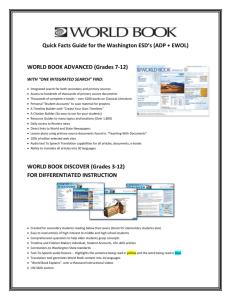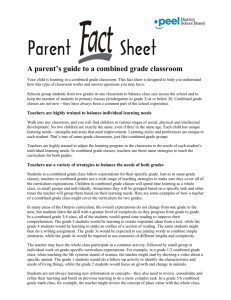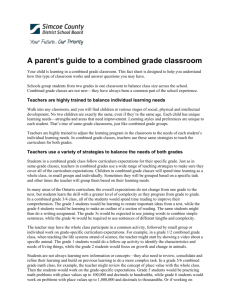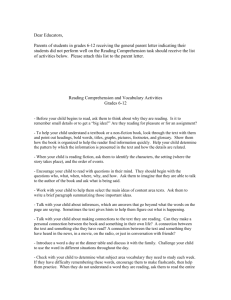Standard 1: Reading SIXTH GRADE
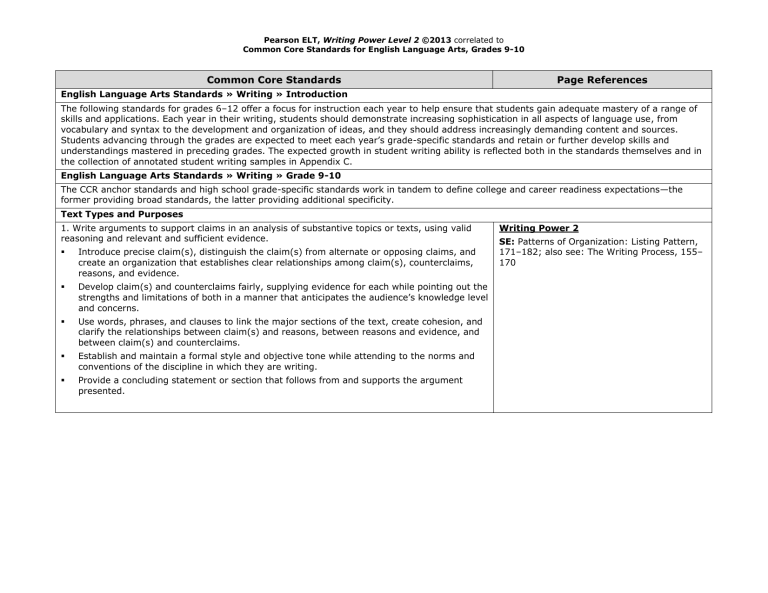
Pearson ELT, Writing Power Level 2 ©2013 correlated to
Common Core Standards for English Language Arts, Grades 9-10
Common Core Standards
English Language Arts Standards » Writing » Introduction
Page References
The following standards for grades 6–12 offer a focus for instruction each year to help ensure that students gain adequate mastery of a range of skills and applications. Each year in their writing, students should demonstrate increasing sophistication in all aspects of language use, from vocabulary and syntax to the development and organization of ideas, and they should address increasingly demanding content and sources.
Students advancing through the grades are expected to meet each year’s grade-specific standards and retain or further develop skills and understandings mastered in preceding grades. The expected growth in student writing ability is reflected both in the standards themselves and in the collection of annotated student writing samples in Appendix C.
English Language Arts Standards » Writing » Grade 9-10
The CCR anchor standards and high school grade-specific standards work in tandem to define college and career readiness expectations—the former providing broad standards, the latter providing additional specificity.
Text Types and Purposes
1. Write arguments to support claims in an analysis of substantive topics or texts, using valid reasoning and relevant and sufficient evidence.
Introduce precise claim(s), distinguish the claim(s) from alternate or opposing claims, and create an organization that establishes clear relationships among claim(s), counterclaims, reasons, and evidence.
Develop claim(s) and counterclaims fairly, supplying evidence for each while pointing out the strengths and limitations of both in a manner that anticipates the audience’s knowledge level and concerns.
Use words, phrases, and clauses to link the major sections of the text, create cohesion, and clarify the relationships between claim(s) and reasons, between reasons and evidence, and between claim(s) and counterclaims.
Establish and maintain a formal style and objective tone while attending to the norms and conventions of the discipline in which they are writing.
Provide a concluding statement or section that follows from and supports the argument presented.
Writing Power 2
SE: Patterns of Organization: Listing Pattern,
171–182; also see: The Writing Process, 155–
170
Pearson ELT, Writing Power Level 2 ©2013 correlated to
Common Core Standards for English Language Arts, Grades 9-10
Text Types and Purposes
2. Write informative/explanatory texts to examine and convey complex ideas, concepts, and information clearly and accurately through the effective selection, organization, and analysis of content.
Introduce a topic; organize complex ideas, concepts, and information to make important connections and distinctions; include formatting (e.g., headings), graphics (e.g., figures, tables), and multimedia when useful to aiding comprehension.
Develop the topic with well-chosen, relevant, and sufficient facts, extended definitions, concrete details, quotations, or other information and examples appropriate to the audience’s knowledge of the topic.
Use appropriate and varied transitions to link the major sections of the text, create cohesion, and clarify the relationships among complex ideas and concepts.
Use precise language and domain-specific vocabulary to manage the complexity of the topic.
Establish and maintain a formal style and objective tone while attending to the norms and conventions of the discipline in which they are writing.
Provide a concluding statement or section that follows from and supports the information or explanation presented (e.g., articulating implications or the significance of the topic).
3. Write narratives to develop real or imagined experiences or events using effective technique, well-chosen details, and well-structured event sequences.
Engage and orient the reader by setting out a problem, situation, or observation, establishing one or multiple point(s) of view, and introducing a narrator and/or characters; create a smooth progression of experiences or events.
Use narrative techniques, such as dialogue, pacing, description, reflection, and multiple plot lines, to develop experiences, events, and/or characters.
Use a variety of techniques to sequence events so that they build on one another to create a coherent whole.
Use precise words and phrases, telling details, and sensory language to convey a vivid picture of the experiences, events, setting, and/or characters.
Provide a conclusion that follows from and reflects on what is experienced, observed, or resolved over the course of the narrative.
Writing Power 2
SE: Writing a Description, 31–32; Write About a Musician, Dancer, or an Artist, 45–46; Write
About Inventions, 53–54; Business Letters,
111–118; Write a Business Letter, 119;
Business Emails, 128–132; Patterns of
Organization: Comparison and Contrast, 194–
204; Write an Academic Paragraph, 153–154;
Patterns of Organization: Time Order Pattern,
183–193; Patterns of Organization:
Comparison and Contrast, 194–204; also see:
The Writing Process, 155–170
Writing Power 2
SE: Write About What People Are Doing, 59–
60; Write About a Classmate’s Childhood, 68–
69; Write About Your Life in the Future, 79
Begin Writing in Your Journal, 93; Story
Chains, 266–267; Story Prompts, 268–269;
Writing Persona Poems, 270–272; Writing
Acrostic Poems, 273–274; also see: The
Writing Process, 155–170
Pearson ELT, Writing Power Level 2 ©2013 correlated to
Common Core Standards for English Language Arts, Grades 9-10
Production and Distribution of Writing
4. Produce clear and coherent writing in which the development, organization, and style are appropriate to task, purpose, and audience. (Grade-specific expectations for writing types are defined in standards 1–3 above.)
5. Develop and strengthen writing as needed by planning, revising, editing, rewriting, or trying a new approach, focusing on addressing what is most significant for a specific purpose and audience.
6. Use technology, including the Internet, to produce, publish, and update individual or shared writing products, taking advantage of technology’s capacity to link to other information and to display information flexibly and dynamically.
Writing Power 2
SE: Writing Task, 17, 31–32, 45–46, 53–54,
59–60, 68–69, 79, 93, 103–104, 110, 119,
127, 132, 153–154, 180–182, 182–193, 203–
204
Writing Power 2
SE: The Writing Process, 155–170; also see:
Writing Task, 17, 31–32, 45–46, 53–54, 59–
60, 68–69, 79, 93, 103–104, 110, 119, 127,
132, 153–154, 180–182, 182–193, 203–204
Writing Power 2
SE: For related material see: Blogging, 94–
104; Writing Emails, 120–132; Using Online
Dictionaries, 231
Research to Build and Present Knowledge
7. Conduct short as well as more sustained research projects to answer a question (including a self-generated question) or solve a problem; narrow or broaden the inquiry when appropriate; synthesize multiple sources on the subject, demonstrating understanding of the subject under investigation.
8. Gather relevant information from multiple authoritative print and digital sources, using advanced searches effectively; assess the usefulness of each source in answering the research question; integrate information into the text selectively to maintain the flow of ideas, avoiding plagiarism and following a standard format for citation.
Writing Power 2
SE: For related material see: Write About a
Musician, Dancer, or an Artist, 45–46; Write
About Inventions, 53–54
Writing Power 2
SE: For related material see: Write About a
Musician, Dancer, or an Artist, 45–46; Write
About Inventions, 53–54
Research to Build and Present Knowledge
9. Draw evidence from literary or informational texts to support analysis, reflection, and research.
Apply grades 9–10 Reading standards to literature (e.g., “Analyze how an author draws on and transforms source material in a specific work [e.g., how Shakespeare treats a theme or topic from Ovid or the Bible or how a later author draws on a play by
Shakespeare]”).
Apply grades 9–10 Reading standards to literary nonfiction (e.g., “Delineate and evaluate the argument and specific claims in a text, assessing whether the reasoning is valid and the evidence is relevant and sufficient; identify false statements and fallacious reasoning”).
Writing Power 2
SE: For related material see: The Writing
Process, 155–170; Listing Pattern (students can use this organization skill to write about books), 171–182
Writing Power 2
SE: For related material see: The Writing
Process, 155–170; Listing Pattern (students can use this organization skill to write about books), 171–182
Pearson ELT, Writing Power Level 2 ©2013 correlated to
Common Core Standards for English Language Arts, Grades 9-10
Range of Writing
10. Write routinely over extended time frames (time for research, reflection, and revision) and shorter time frames (a single sitting or a day or two) for a range of tasks, purposes, and audiences.
Writing Power 2
SE: Writing Task, 17, 31–32, 45–46, 53–54,
59–60, 68–69, 79, 93, 103–104, 110, 119,
127, 132, 153–154, 180–182, 182–193, 203–
204
The CCR anchor standards and high school grade-specific standards work in tandem to define college and career readiness expectations—the former providing broad standards, the latter providing additional specificity.
English Language Arts Standards » Speaking & Listening » Introduction
The following standards for grades 6–12 offer a focus for instruction in each year to help ensure that students gain adequate mastery of a range of skills and applications. Students advancing through the grades are expected to meet each year’s grade-specific standards and retain or further develop skills and understandings mastered in preceding grades.
English Language Arts Standards » Speaking & Listening » Grade 9-10
The CCR anchor standards and high school grade-specific standards work in tandem to define college and career readiness expectations—the former providing broad standards, the latter providing additional specificity.
Comprehension and Collaboration
1. Initiate and participate effectively in a range of collaborative discussions (one-on-one, in groups, and teacher-led) with diverse partners on grades 9–10 topics, texts, and issues, building on others’ ideas and expressing their own clearly and persuasively.
Come to discussions prepared, having read and researched material under study; explicitly draw on that preparation by referring to evidence from texts and other research on the topic or issue to stimulate a thoughtful, well-reasoned exchange of ideas.
Work with peers to set rules for collegial discussions and decision-making (e.g., informal consensus, taking votes on key issues, presentation of alternate views), clear goals and deadlines, and individual roles as needed.
Propel conversations by posing and responding to questions that relate the current discussion to broader themes or larger ideas; actively incorporate others into the discussion; and clarify, verify, or challenge ideas and conclusions.
Respond thoughtfully to diverse perspectives, summarize points of agreement and disagreement, and, when warranted, qualify or justify their own views and understanding and make new connections in light of the evidence and reasoning presented.
2. Integrate multiple sources of information presented in diverse media or formats (e.g., visually, quantitatively, orally) evaluating the credibility and accuracy of each source.
Writing Power 2
SE: Warm Up, 2, 18, 33, 47, 61, 70, 82, 94,
105, 120, 134, 155, 171, 183, 194, 206, 217,
232, 250, 265
Writing Power 2
SE: For related material see: Blogging, 94–
104; Writing Emails, 120–132; Using Online
Dictionaries, 231
Pearson ELT, Writing Power Level 2 ©2013 correlated to
Common Core Standards for English Language Arts, Grades 9-10
Presentation of Knowledge and Ideas
5. Make strategic use of digital media (e.g., textual, graphical, audio, visual, and interactive elements) in presentations to enhance understanding of findings, reasoning, and evidence and to add interest.
6. Adapt speech to a variety of contexts and tasks, demonstrating command of formal English when indicated or appropriate.
Writing Power 2
SE: For related material see: Blogging, 94–
104; Writing Emails, 120–132; Using Online
Dictionaries, 231
Writing Power 2
SE: Warm Up, 2, 18, 33, 47, 61, 70, 82, 94,
105, 120, 134, 155, 171, 183, 194, 206, 217,
232, 250, 265
English Language Arts Standards » Language » Introduction
The following standards for grades 6–12 offer a focus for instruction each year to help ensure that students gain adequate mastery of a range of skills and applications. Students advancing through the grades are expected to meet each year’s grade-specific standards and retain or further develop skills and understandings mastered in preceding grades. Beginning in grade 3, skills and understandings that are particularly likely to require continued attention in higher grades as they are applied to increasingly sophisticated writing and speaking are marked with an asterisk
(*).
English Language Arts Standards » Language » Grade 9-10
Conventions of Standard English
1. Demonstrate command of the conventions of standard English grammar and usage when writing or speaking.
Use parallel structure.*
Use various types of phrases (noun, verb, adjectival, adverbial, participial, prepositional, absolute) and clauses (independent, dependent; noun, relative, adverbial) to convey specific meanings and add variety and interest to writing or presentations.
Writing Power 2
SE: For related material see: Simple
Sentences, 2–17; Compound and Complex
Sentences, 33–46
Writing Power 2
SE: For related material see: Simple
Sentences, 2–17; Compound and Complex
Sentences, 33–46
2. Demonstrate command of the conventions of standard English capitalization, punctuation, and spelling when writing.
Use a semicolon (and perhaps a conjunctive adverb) to link two or more closely related independent clauses.
Writing Power 2
SE: For related material see: Simple
Sentences, 2–17; Compound and Complex
Sentences, 33–46
Use a colon to introduce a list or quotation. Writing Power 2
SE: Punctuation Rules: Colon, 282; also see colon use in the section the following Unit:
Blogging, 94–104; Writing Letters, 105–119;
Writing Emails, 120–132
Spell correctly.
Pearson ELT, Writing Power Level 2 ©2013 correlated to
Common Core Standards for English Language Arts, Grades 9-10
Writing Power 2
SE: Dictionary Skills: Using a Dictionary, 218–
231; Formal and Informal Words, 226;
Synonyms and Antonyms, 226–228; Using the
Thesaurus in a Dictionary, 229–230; Using
Online Dictionaries, 231; Word Parts: Prefixes,
233–239; Suffixes, 240–246; Word Families,
247–249; Spelling Rules, 275–276; Frequently
Used Words in English, 283
Knowledge of Language
3. Apply knowledge of language to understand how language functions in different contexts, to make effective choices for meaning or style, and to comprehend more fully when reading or listening.
Write and edit work so that it conforms to the guidelines in a style manual (e.g., MLA
Handbook, Turabian’s Manual for Writers) appropriate for the discipline and writing type.
Writing Power 2
SE: The Writing Process, 155–170; Grammar and Spelling Guide, 275–282; also see:
Writing Task, 17, 31–32, 45–46, 53–54, 59–
60, 68–69, 79, 93, 103–104, 110, 119, 127,
132, 153–154, 180–182, 182–193, 203–204
Vocabulary Acquisition and Use
4. Determine or clarify the meaning of unknown and multiple-meaning words and phrases based on grades 9–10 reading and content, choosing flexibly from a range of strategies.
Use context (e.g., the overall meaning of a sentence, paragraph, or text; a word’s position or function in a sentence) as a clue to the meaning of a word or phrase.
Writing Power 2
SE: Vocabulary Building Strategies, 206–216
Identify and correctly use patterns of word changes that indicate different meanings or parts of speech (e.g., analyze, analysis, analytical; advocate, advocacy).
Writing Power 2
SE: Word Parts: Prefixes, 233–239; Suffixes,
240–246; Word Families, 247–249
Consult general and specialized reference materials (e.g., dictionaries, glossaries, thesauruses), both print and digital, to find the pronunciation of a word or determine or clarify its precise meaning, its part of speech, or its etymology.
Writing Power 2
SE: Dictionary Skills: Using a Dictionary, 218–
231; Formal and Informal Words, 226;
Synonyms and Antonyms, 226–228; Using the
Thesaurus in a Dictionary, 229–230; Using
Online Dictionaries, 231
Verify the preliminary determination of the meaning of a word or phrase (e.g., by checking the inferred meaning in context or in a dictionary).
Writing Power 2
SE: Dictionary Skills: Using a Dictionary, 218–
231; Formal and Informal Words, 226;
Synonyms and Antonyms, 226–228; Using the
Thesaurus in a Dictionary, 229–230; Using
Online Dictionaries, 231
5. Demonstrate understanding of figurative language, word relationships, and nuances in word meanings.
Pearson ELT, Writing Power Level 2 ©2013 correlated to
Common Core Standards for English Language Arts, Grades 9-10
Interpret figures of speech (e.g., euphemism, oxymoron) in context and analyze their role in the text.
Writing Power 2
SE: For related material see: Keep a
Vocabulary Notebook, 210–213; Practice,
Review, Repeat, 216; Writing Persona Poems,
270–272; Writing Acrostic Poems, 273–274
Analyze nuances in the meaning of words with similar denotations.
6. Acquire and use accurately general academic and domain-specific words and phrases, sufficient for reading, writing, speaking, and listening at the college and career readiness level; demonstrate independence in gathering vocabulary knowledge when considering a word or phrase important to comprehension or expression.
Writing Power 2
SE: Using a Dictionary, 218–231; Synonyms and Antonyms, 226–228; Using the Thesaurus in a Dictionary, 229–230
Writing Power 2
SE: Vocabulary Building Strategies, 206–216;
Dictionary Skills, 2217–231; Word Parts, 232–
249; Using Words Together, 250–264 http://corestandards.org/the-standards/english-language-arts-standards


